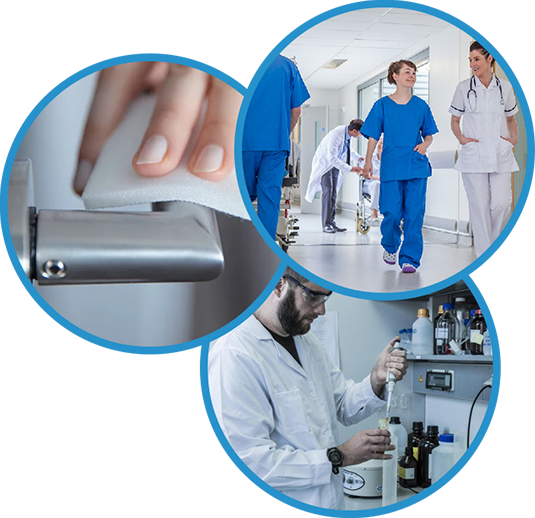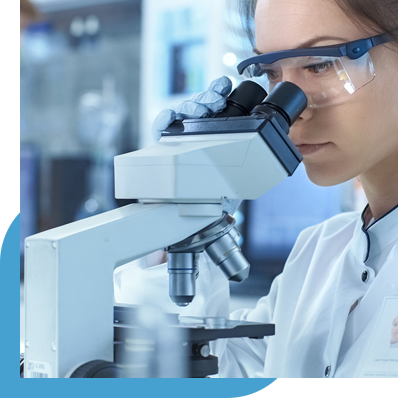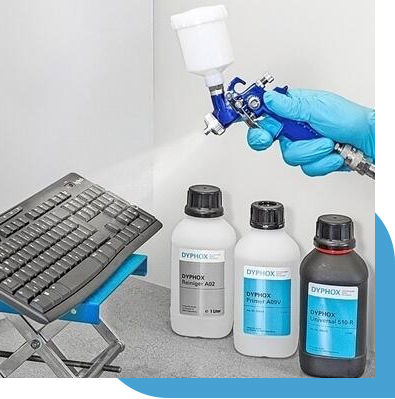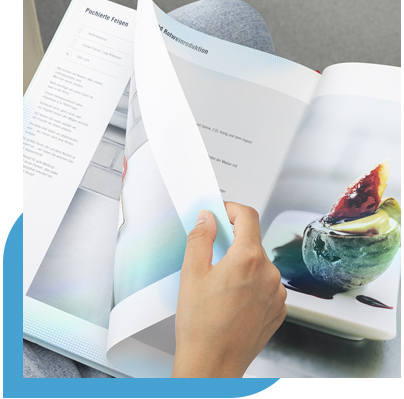Antimicrobial effectiveness
Antimicrobial coatings
and healthcare
While good hygiene is important in any industry, few environments require more rigorous sanitation standards than hospitals. Manual cleaning does not offer an adequate level of protection against the spread of infection. An alternative solution is required to protect hospitals’ staff, patients and visitors. Dyphox’s comprehensive antimicrobial technology for surfaces bridges the hygiene gap by killing bacteria and viruses with 99% efficacy, and reducing the risk of high germ contamination by up to 67%.

Effective against all viruses, bacteria and fungi
*ISO 22196 (mod.) **ISO 21702 (mod.)

Raise infection control standards

99.99% effectiveness* proven in and out of laboratories

Decreased risk of transmission

Higher staff attendance & peace of mind for patients

Long-lasting, low-cost hospital surface disinfectant offering minimised disruption

How antimicrobial surfaces improve
infection control standards in hospitals
Treatment of commonly touched surfaces, including door knobs, handrails, light switches, toilets, food trays and equipment.
Application in shared areas, such as the canteen, bathrooms, offices and reception.
Works on aluminium, plastics, steel, glass and lacquered furniture.
Offers long lasting surface disinfection for 12 months on indoor surfaces and 6 months on outdoor surfaces
The only antimicrobial solution appropriate for use in hospitals and nursing homes.

Interested in more details?
Download the brochure for further information.
How Dyphox works
Dyphox is applied as a liquid solution, and once dry, retroactively kills 99.99% of bacteria,
viruses and fungi contaminating the surface.
By modifying photocatalysts, the Dyphox team identified molecules that were capable of self-sanitising when exposed to light. Exposure to any form of light, whether natural or artificial, activates Dyphox’s antimicrobial effect when oxygen is present.
By modifying photocatalysts, the Dyphox team identified molecules that were capable of self-sanitising when exposed to light. Exposure to any form of light, whether natural or artificial, activates Dyphox’s antimicrobial effect when oxygen is present.
The singlet oxygen is large enough to be effective in killing germs but is not released into the surrounding environment. Dyphox is non-toxic to humans and the environment.
How Dyphox works
Dyphox is applied as a liquid solution, and once dry, retroactively kills 99.99% of bacteria,
viruses and fungi contaminating the surface.

By modifying photocatalysts, the Dyphox team identified molecules that were capable of self-sanitising when exposed to light. Exposure to any form of light, whether natural or artificial, activates Dyphox’s antimicrobial effect when oxygen is present.

Based on photodynamics, the excitation of a photocatalyst by visible light (400–700 nm) leads to the creation of singlet oxygen by transferring the absorbed energy to ambient oxygen. The photodynamic effect induces fast and effective oxidative degeneration of the bacterial wall, and the bacterium quickly dies.

The singlet oxygen is large enough to be effective in killing germs but is not released into the surrounding environment. Dyphox is non-toxic to humans and the environment.
Ready to break the chain of infection?
Want to learn more about Dyphox’s technology works? Our team is happy to arrange a call to discuss your needs and questions.
Don’t take our word for it, see what our clients have to say.

We were so Impressed with Rory's presentation that we instantly commissioned Healthy Surfaces to coat all the surfaces in our clinics with Dyphox.
Dyphox has been an incredible success for us, a game changer. Overnight we were confidently in a position to offer our staff and patients a layer of protection that they didn't expect. Together with the standard PE garments they wear daily, they now had a secondary barrier against the spread of Covid and other bacteria.
In our opinion, Dyphox is a super product that does exactly what it says it can do. MyMedical has no hesitation in highly recommending Dyphox to any Medical facility or indeed any industry! Please do not hesitate to contact me personally should anyone require further clarification."
Gerard Egan
CEO - MyMedical


We value the health of our residents, staff and visitors and made the easy decision to apply Dyphox to all high-touch points around our nursing home. Being able to kill germs in between our cleaning cycles is a serious game changer for us. Our residents deserve to live in the healthiest environment possible, this in turn provides a safer environment for our staff – which in my book is a big win! Win!
I would highly recommend getting in touch with Rory and his team in Healthy Surfaces – Not only does the end product provide the safest environment – the team worked almost un-noticeably, which allowed our residents to continue about their daily lives with virtually no disruption."
Sheila King
COO Passage Health Care Int Ire Ltd.

